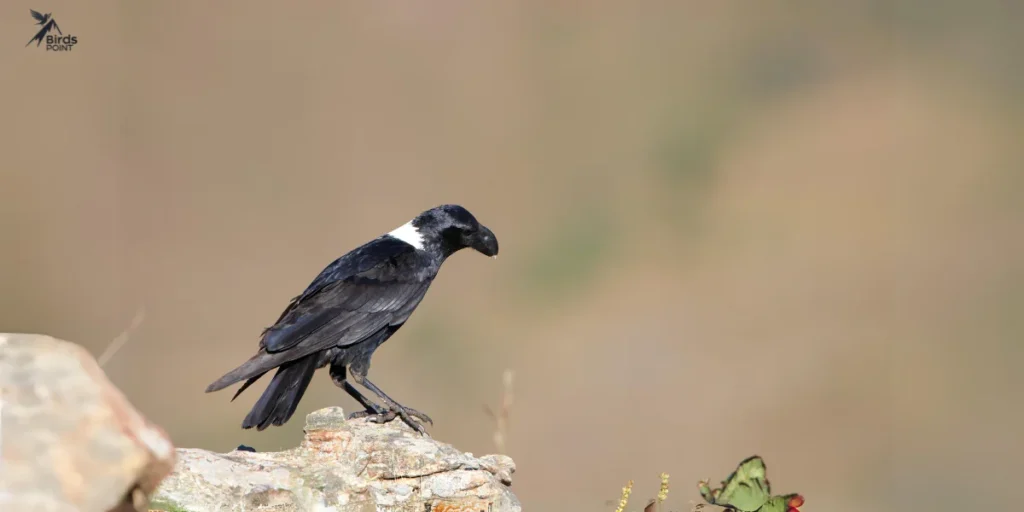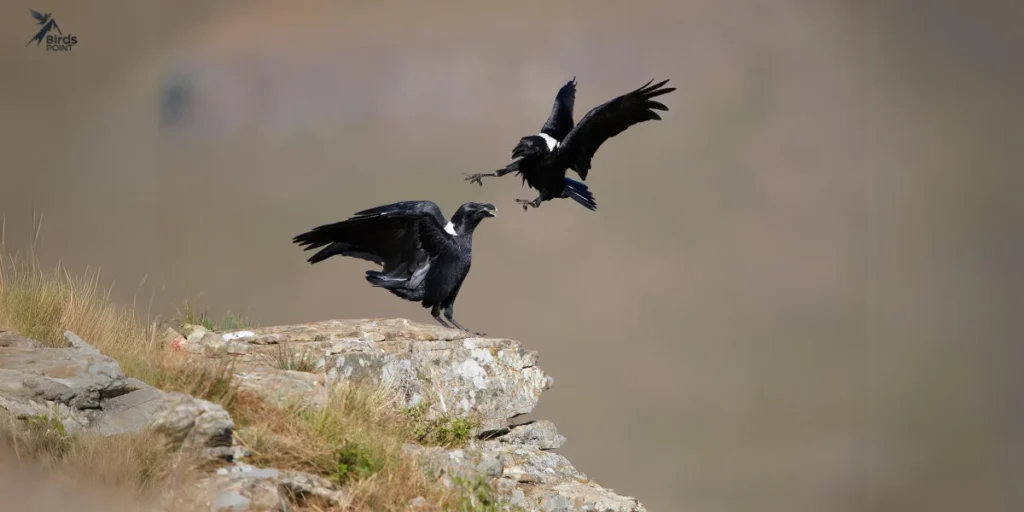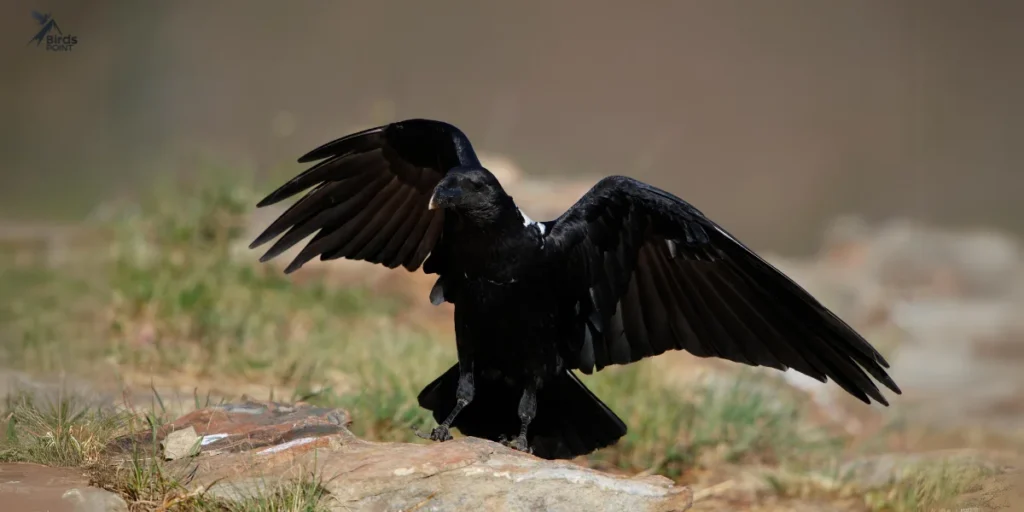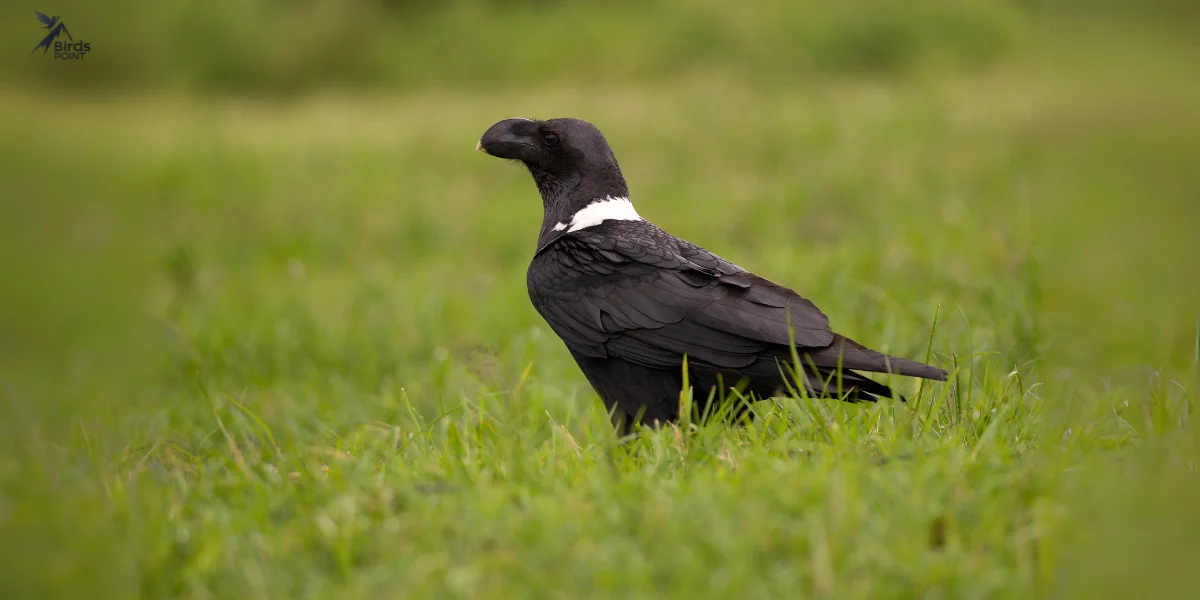The White-necked Raven is a large bird known for its black feathers and a white patch on the back of its neck, which gives it its name. These ravens are found mainly in eastern and Southern Africa. They are intelligent birds, often seen flying high in the sky or perched on trees and rocks. White-necked Ravens have strong beaks that they use to eat a variety of foods, including insects, fruits, and even small animals. Their loud, deep calls are a common sound in the areas they live in. These birds are also known for their playful behavior, often seen gliding in the air or playing with each other.
White-necked Raven
The White-necked Raven is a large black bird with a white patch on its neck. It lives in Africa and is known for being very smart. This raven eats many different foods like insects, fruits, and small animals. It has a strong beak and makes loud, deep calls. You can often see it flying high or sitting on trees and rocks.

Introduction to the White-necked Raven
The White-necked Raven is a striking bird known for its distinctive black feathers and a white patch on its neck. This intelligent bird is found primarily in Africa, where it has adapted to various habitats, including savannas, mountains, and human settlements. In this detailed article, we will delve into the physical characteristics, habitat, diet, behavior, reproduction, and more about the White-necked Raven. We will also include some tables to better illustrate key information.
Physical Characteristics
The White-necked Raven is a large bird with a wingspan that can reach up to 1.2 meters (about 4 feet). Its body is mostly black, but the white patch on the back of its neck is a defining feature. This bird also has a powerful beak, which is slightly curved and extremely strong, making it well-suited for breaking open tough food items like nuts and bones.
Physical Characteristics of the White-necked Raven
| Characteristic | Description |
|---|---|
| Wingspan | Up to 1.2 meters (about 4 feet) |
| Body Color | Black with a white patch on the neck |
| Beak | Thick, curved, and strong |
| Legs and Feet | Strong, adapted for walking and perching |
| Feather Sheen | Bluish or purplish sheen in sunlight |
The White-necked Raven’s thick and powerful beak is particularly notable for its ability to break through tough materials, allowing the bird to access a wide range of foods that other animals might not be able to eat.
Habitat and Range
The White-necked Raven is native to Africa, with a range that spans the eastern and southern regions of the continent. It thrives in various environments, from coastal areas to high mountains. This adaptability allows the White-necked Raven to live in different types of habitats, such as:
- Savannas: Open grasslands where the raven can easily spot prey or scavenge for food.
- Mountains: High altitudes provide safe nesting sites away from predators.
- Cliffs: Natural ledges and rocky outcrops are ideal for nesting and roosting.
- Human Settlements: These birds often scavenge near human dwellings, taking advantage of food scraps and other resources.
Habitat and Range of the White-necked Raven
| Habitat Type | Description | Examples of Locations |
|---|---|---|
| Savannas | Open grasslands with scattered trees | Serengeti National Park, Tanzania |
| Mountains | High altitudes with rocky terrain | Drakensberg Mountains, South Africa |
| Cliffs | Steep, rocky areas providing safe nesting sites | Simien Mountains, Ethiopia |
| Human Areas | Villages, towns, and cities where food is readily available | Nairobi, Kenya; Addis Ababa, Ethiopia |
The bird’s ability to adapt to different environments is a key reason why its population remains stable across its range.
Diet and Feeding Habits
The White-necked Raven is an omnivore with a diverse diet. Its strong beak allows it to consume a wide range of foods, making it one of the most versatile feeders among birds. The raven’s diet includes:
- Insects: Beetles, ants, and grasshoppers are common prey.
- Small Mammals: Rodents and other small animals provide a rich source of protein.
- Birds and Reptiles: The raven occasionally preys on smaller birds and reptiles.
- Fruits and Seeds: Various fruits and seeds are a significant part of its diet, especially during certain seasons.
- Carrion: As a scavenger, the White-necked Raven often feeds on the remains of dead animals.
- Human Waste: In areas near human settlements, these ravens scavenge in garbage dumps and around homes.
Diet of the White-necked Raven
| Food Type | Examples | Feeding Behavior |
|---|---|---|
| Insects | Beetles, ants, grasshoppers | Actively hunts or digs for insects in the ground |
| Small Mammals | Rodents, shrews | Hunts and captures live prey |
| Birds/Reptiles | Smaller bird species, lizards | Occasionally preys on smaller birds and reptiles |
| Fruits/Seeds | Berries, nuts, seeds | Gathers from trees, shrubs, and the ground |
| Carrion | Dead animals, roadkill | Scavenges carcasses left by other predators or accidents |
| Human Waste | Food scraps, garbage | Forages in garbage dumps and near human dwellings |
This varied diet allows the White-necked Raven to thrive in different environments, making it a highly adaptable species.
Behavior and Social Structure
White-necked Ravens are social birds that often form pairs or small groups. They are known for their playful nature, engaging in aerial acrobatics and games with one another. These birds are also very vocal, using a variety of calls to communicate with each other. Their vocalizations are deep and loud, making them easily recognizable.
Social and Behavioral Traits of the White-necked Raven
| Behavior | Description |
|---|---|
| Social Structure | Usually found in pairs or small groups |
| Playful Behavior | Engages in aerial acrobatics and playful interactions |
| Vocal Communication | Uses a variety of deep, loud calls to communicate |
| Territorial | Defends nesting sites from other birds and predators |
| Tool Use | Known to use sticks and rocks to access food |

Reproduction and Lifespan
The White-necked Raven’s breeding season typically aligns with the dry season. During this time, the female lays 3 to 5 eggs, which are incubated for about 20 to 25 days. The male assists by providing food to the female during the incubation period. After hatching, both parents take turns feeding the chicks.
The chicks remain in the nest for several weeks before they are strong enough to fly. Once they leave the nest, they continue to stay close to their parents, learning vital survival skills.
Reproductive Details of the White-necked Raven
| Aspect | Description |
|---|---|
| Breeding Season | Typically during the dry season |
| Number of Eggs | 3 to 5 eggs per clutch |
| Incubation Period | 20 to 25 days |
| Parental Care | Both parents feed and protect the chicks |
| Fledgling Period | Chicks leave the nest after several weeks |
In the wild, the White-necked Raven can live up to 15 years, although its lifespan may be longer in captivity, where it is protected from predators and has a consistent food supply.
Role in the Ecosystem
The White-necked Raven plays a crucial role in its ecosystem. As both a predator and a scavenger, it helps control the populations of various species and cleans up dead animals, which reduces the spread of disease. Additionally, these ravens contribute to seed dispersal, which aids in the growth of plants and the overall health of the environment.
Ecological Roles of the White-necked Raven
| Role | Description |
|---|---|
| Predator | Controls populations of insects, small mammals, and other prey |
| Scavenger | Cleans up carrion, reducing the risk of disease spread |
| Seed Disperser | Helps in the growth of plants by dispersing seeds |
| Ecosystem Balance | Contributes to maintaining a balanced ecosystem |
Interaction with Humans
White-necked Ravens have a complex relationship with humans. In some cultures, they are revered as symbols of intelligence and wisdom, while in others, they may be considered pests due to their scavenging habits. Despite these differing views, the raven’s presence near human settlements often benefits both the bird and people, as it helps control pests and clean up waste.
Human-Raven Interactions
| Interaction Type | Description |
|---|---|
| Cultural Symbolism | Seen as symbols of intelligence, wisdom, or omens in various cultures |
| Scavenging | Feeds on human waste, which helps in waste management |
| Pest Control | Controls populations of pests in agricultural areas |
| Conflicts | Sometimes considered a pest by farmers due to crop damage |
Conservation Status
The White-necked Raven is currently listed as a species of “Least Concern” by conservation organizations. Its population remains stable across its range, thanks to its adaptability and the variety of habitats it can live in. However, like many species, it faces threats from habitat loss and climate change. Conservation efforts focus on protecting the natural habitats of these birds and ensuring their continued survival.
Conservation Status of the White-necked Raven
| Status | Description |
|---|---|
| IUCN Red List | Least Concern |
| Population Trend | Stable across its range |
| Threats | Habitat loss, climate change, human encroachment |
| Conservation Efforts | Habitat protection, research, and monitoring |

Interesting Facts About the White-necked Raven
- Tool Use: The White-necked Raven is known for using tools, such as sticks and rocks, to help it access food. This behavior is a clear sign of its high intelligence.
- Complex Communication: These ravens have a wide range of vocalizations, which they use to communicate with each other. They can even mimic the sounds of other animals.
- Playfulness: White-necked Ravens are playful birds, often seen engaging in games and aerial acrobatics with each other.
- Longevity: In the wild, these ravens can live up to 15 years, with some individuals living even longer in captivity.
- Cultural Significance: In some cultures, ravens are revered as symbols of wisdom and intelligence, while in others, they are associated with mystery or bad omens.
Conclusion
The White-necked Raven is a remarkable bird, known for its intelligence, adaptability, and distinctive appearance. It plays a vital role in the ecosystems of Africa, helping to control populations of prey species, clean up carrion, and disperse seeds. While it is currently not endangered, continued conservation efforts are important to ensure that this fascinating bird continues to thrive in its natural habitat.
With its unique characteristics and important ecological role, the White-necked Raven stands out as one of the most interesting and valuable bird species in the world. Whether soaring through the skies, scavenging for food, or interacting with other ravens, this bird never fails to impress. As we continue to learn more about the White-necked Raven, it is clear that this bird is much more than just a common raven—it is a symbol of the incredible adaptability and intelligence found in the animal kingdom.
FAQs
- What is the White-necked Raven?
- It’s a large African bird with black feathers and a white neck patch.
- Where is the White-necked Raven found?
- It’s found in eastern and southern Africa across various habitats.
- What does the White-necked Raven eat?
- It eats insects, small animals, fruits, seeds, carrion, and human waste.
- How long does the White-necked Raven live?
- It can live up to 10-15 years in the wild.
- Is the White-necked Raven endangered?
- No, it’s listed as “Least Concern.”
- Are White-necked Ravens social birds?
- Yes, they are often seen in pairs or small groups.
- What unique behaviors does the White-necked Raven have?
- It uses tools to access food and engages in playful activities.
- Do White-necked Ravens interact with humans?
- Yes, they often scavenge near human settlements.
- Can White-necked Ravens mimic sounds?
- Yes, they can mimic other birds and various sounds.
- Why are White-necked Ravens considered intelligent?
- They are known for problem-solving skills, tool use, and adaptability.

oexofb